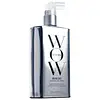What's inside
What's inside
 Key Ingredients
Key Ingredients

No key ingredients
 Benefits
Benefits

 Concerns
Concerns

No concerns
 Ingredients Side-by-side
Ingredients Side-by-side

Water
Skin ConditioningDipropylene Glycol
HumectantPolysilicone-29
Silicone Quaternium-18
EmollientPEG-40 Hydrogenated Castor Oil
EmulsifyingPhenoxyethanol
PreservativeParfum
MaskingTrideceth-6
EmulsifyingDeceth-7
EmulsifyingCocamidopropyl Betaine
CleansingBHT
AntioxidantDisodium EDTA
Caprylyl Glycol
EmollientHexyl Cinnamal
PerfumingCitric Acid
BufferingIsopropyl Alcohol
SolventLinalool
PerfumingCetearyl Nonanoate
EmollientTriticum Vulgare Germ Oil
EmollientLimonene
PerfumingPotassium Sorbate
PreservativeCaprylic/Capric Triglyceride
MaskingLinoleic Acid
CleansingTriticum Vulgare Bran Extract
Skin ConditioningTriticum Vulgare Germ Extract
Skin ConditioningCamellia Oleifera Seed Oil
Skin ConditioningTocopheryl Acetate
AntioxidantTocopherol
AntioxidantWater, Dipropylene Glycol, Polysilicone-29, Silicone Quaternium-18, PEG-40 Hydrogenated Castor Oil, Phenoxyethanol, Parfum, Trideceth-6, Deceth-7, Cocamidopropyl Betaine, BHT, Disodium EDTA, Caprylyl Glycol, Hexyl Cinnamal, Citric Acid, Isopropyl Alcohol, Linalool, Cetearyl Nonanoate, Triticum Vulgare Germ Oil, Limonene, Potassium Sorbate, Caprylic/Capric Triglyceride, Linoleic Acid, Triticum Vulgare Bran Extract, Triticum Vulgare Germ Extract, Camellia Oleifera Seed Oil, Tocopheryl Acetate, Tocopherol
Water
Skin ConditioningDipropylene Glycol
HumectantPolysilicone-29
Silicone Quaternium-18
EmollientGlycerin
HumectantTrideceth-6
EmulsifyingChamomilla Recutita Flower Extract
MaskingCalendula Officinalis Flower Extract
MaskingPotassium Sorbate
PreservativePhenoxyethanol
PreservativeTrideceth-12
EmulsifyingSodium Benzoate
MaskingChlorphenesin
AntimicrobialPotassium Benzoate
PreservativeDisodium EDTA
Citric Acid
Buffering
 Reviews
Reviews

Ingredients Explained
These ingredients are found in both products.
Ingredients higher up in an ingredient list are typically present in a larger amount.
Citric Acid is an alpha hydroxy acid (AHA) naturally found in citrus fruits like oranges, lemons, and limes.
Like other AHAs, citric acid can exfoliate skin by breaking down the bonds that hold dead skin cells together. This helps reveal smoother and brighter skin underneath.
However, this exfoliating effect only happens at high concentrations (20%) which can be hard to find in cosmetic products.
Due to this, citric acid is usually included in small amounts as a pH adjuster. This helps keep products slightly more acidic and compatible with skin's natural pH.
In skincare formulas, citric acid can:
While it can provide some skin benefits, research shows lactic acid and glycolic acid are generally more effective and less irritating exfoliants.
Most citric acid used in skincare today is made by fermenting sugars (usually from molasses). This synthetic version is identical to the natural citrus form but easier to stabilize and use in formulations.
Read more about some other popular AHA's here:
Learn more about Citric AcidDipropylene Glycol is a synthetically created humectant, stabilizer, and solvent.
This ingredient helps:
Dipropylene glycol is technically an alcohol, but it belongs to the glycol family (often considered part of the ‘good’ alcohols). This means it is hydrating and gentle on skin unlike drying solvent alcohols like denatured alcohol.
As a masking agent, Dipropylene Glycol can be used to cover the smell of other ingredients. However, it does not have a scent.
Studies show Dipropylene Glycol is considered safe to use in skincare.
Learn more about Dipropylene GlycolDisodium EDTA plays a role in making products more stable by aiding other preservatives.
It is a chelating agent, meaning it neutralizes metal ions that may be found in a product.
Disodium EDTA is a salt of edetic acid and is found to be safe in cosmetic ingredients.
Learn more about Disodium EDTAPhenoxyethanol is a preservative that has germicide, antimicrobial, and aromatic properties. Studies show that phenoxyethanol can prevent microbial growth. By itself, it has a scent that is similar to that of a rose.
It's often used in formulations along with Caprylyl Glycol to preserve the shelf life of products.
Polysilicone-29 is a complex silicone polymer. It is also known as Silsoft™ CLX-E.
The manufacturer states this ingredient is a conditioning agent for hair care. The website states this ingredient can help hydrate and repair hair.
It is made up of glycidoxypropyl-terminated dimethyl siloxane polymer, peg-13 diglycidyl ether, diethylaminopropylamine, and aminopropyltriisopropoxysilane.
Learn more about Polysilicone-29Potassium Sorbate is a preservative used to prevent yeast and mold in products. It is commonly found in both cosmetic and food products.
This ingredient comes from potassium salt derived from sorbic acid. Sorbic acid is a natural antibiotic and effective against fungus.
Both potassium sorbate and sorbic acid can be found in baked goods, cheeses, dried meats, dried fruit, ice cream, pickles, wine, yogurt, and more.
You'll often find this ingredient used with other preservatives.
Learn more about Potassium SorbateSilicone Quaternium-18 is a type of silicone.
We don't have a description for Trideceth-6 yet.
Water. It's the most common cosmetic ingredient of all. You'll usually see it at the top of ingredient lists, meaning that it makes up the largest part of the product.
So why is it so popular? Water most often acts as a solvent - this means that it helps dissolve other ingredients into the formulation.
You'll also recognize water as that liquid we all need to stay alive. If you see this, drink a glass of water. Stay hydrated!
Learn more about Water